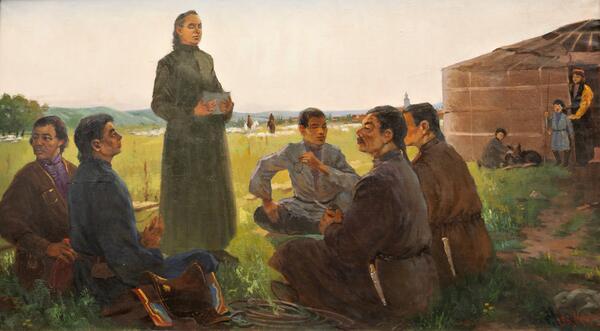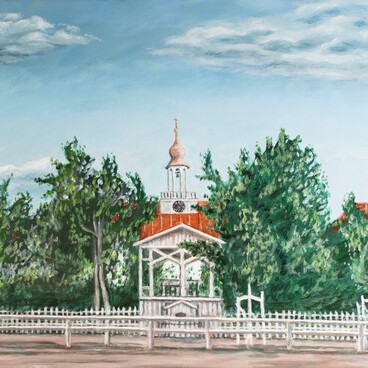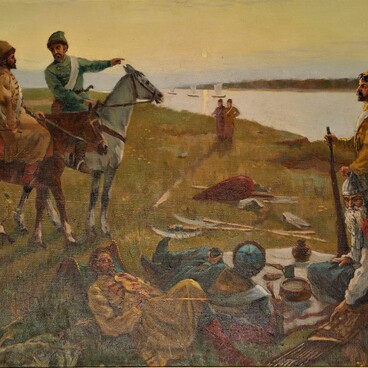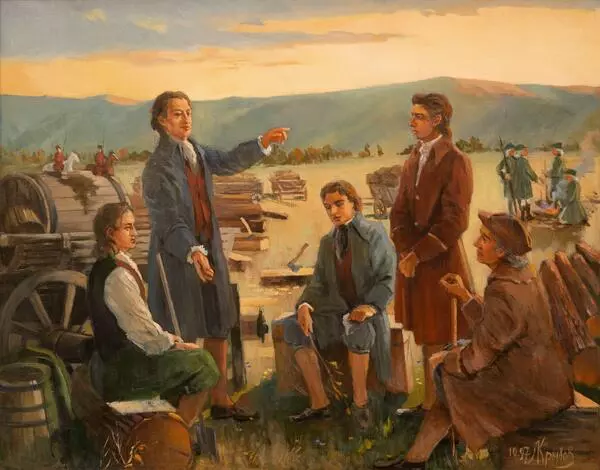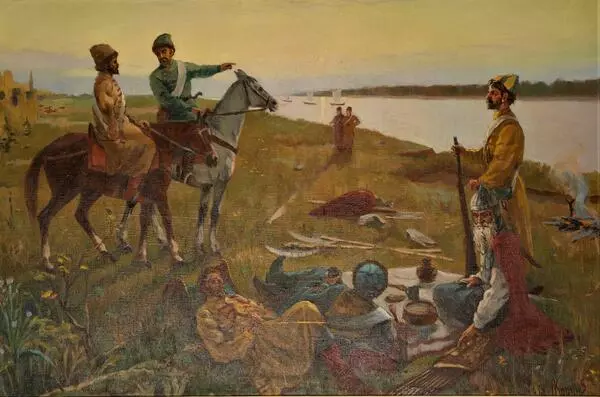The German colony of Sarepta was founded in 1765 as a missionary outpost in Russia. One of the missionaries' goals was the preaching of the Christian doctrine among the nomadic Kalmyks. Lev Krylov’s painting depicts an important moment in the interaction of the Sareptians with their neighbors: one of the missionary brothers turns to the Kalmyks with a sermon.
The development of relationships was facilitated by the need of the Kalmyk population for qualified medical care, which at that time it could only receive in Sarepta. Another factor was mutual interest in trade connections.
Before embarking on missionary work, the Sareptians had to learn the Kalmyk language well. Brothers of the community Johann Neitz, Christian Hamel and Friedrich Malch began to study in 1768 for this work in 1768. The greatest success in this matter was achieved by Neitz, who was an interpreter for Dr. Johann Veer.
The brothers lived among the Kalmyks for a year, adopting their way of life. Neitz was simultaneously engaged in medical activities. At the same time, the Sarepta Gernguters, the Protestants, first discovered that the Kalmyks were not pagans, but adherents of a complex Buddhist teaching and were strongly influenced by the numerous and organized Lamaist clergy.
The Hernguthers, ascetic, avoiding noisy pastime, were shocked by the Kalmyks' free lifestyle. Describing one of the Kalmyk festivals, the brothers wrote: “In the second half of this day, a second half of this day took place for the second time a celebration of drunkenness and gluttony for a hundred young people, most of them women.” At the same time, the Sareptians noted that Kalmyks mostly are sufficiently developed in moral terms and have clear ideas about justice, good and evil.
When visiting Sarepta, Kalmyks often showed interest in craft workshops. Recognizing the achievements of the Sareptians, they emphasized that for themselves working in closed rooms would be too painful, and did not express a desire to change their usual way of life.
Finally, the missionary activity of the Hernguter among the Kalmyks collapsed. However, the Sareptians left a picturesque and detailed description of the Kalmyks' way of life and way of life. The most interesting are descriptions of religious rites, ethnographic sketches of the summer settlements of noyons - Kalmyk princes, the decoration of wagons, the national dress of the Kalmyks, and traditional Kalmyk cuisine.
The relationship between the Kalmyks and the Hernguters of Sarepta was an amazing example of the coexistence and interaction of two completely different, not similar cultures.
The development of relationships was facilitated by the need of the Kalmyk population for qualified medical care, which at that time it could only receive in Sarepta. Another factor was mutual interest in trade connections.
Before embarking on missionary work, the Sareptians had to learn the Kalmyk language well. Brothers of the community Johann Neitz, Christian Hamel and Friedrich Malch began to study in 1768 for this work in 1768. The greatest success in this matter was achieved by Neitz, who was an interpreter for Dr. Johann Veer.
The brothers lived among the Kalmyks for a year, adopting their way of life. Neitz was simultaneously engaged in medical activities. At the same time, the Sarepta Gernguters, the Protestants, first discovered that the Kalmyks were not pagans, but adherents of a complex Buddhist teaching and were strongly influenced by the numerous and organized Lamaist clergy.
The Hernguthers, ascetic, avoiding noisy pastime, were shocked by the Kalmyks' free lifestyle. Describing one of the Kalmyk festivals, the brothers wrote: “In the second half of this day, a second half of this day took place for the second time a celebration of drunkenness and gluttony for a hundred young people, most of them women.” At the same time, the Sareptians noted that Kalmyks mostly are sufficiently developed in moral terms and have clear ideas about justice, good and evil.
When visiting Sarepta, Kalmyks often showed interest in craft workshops. Recognizing the achievements of the Sareptians, they emphasized that for themselves working in closed rooms would be too painful, and did not express a desire to change their usual way of life.
Finally, the missionary activity of the Hernguter among the Kalmyks collapsed. However, the Sareptians left a picturesque and detailed description of the Kalmyks' way of life and way of life. The most interesting are descriptions of religious rites, ethnographic sketches of the summer settlements of noyons - Kalmyk princes, the decoration of wagons, the national dress of the Kalmyks, and traditional Kalmyk cuisine.
The relationship between the Kalmyks and the Hernguters of Sarepta was an amazing example of the coexistence and interaction of two completely different, not similar cultures.

